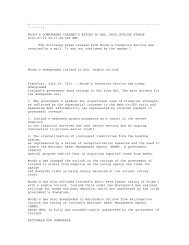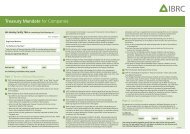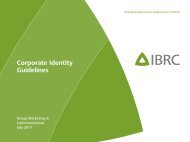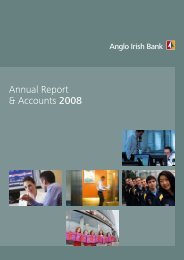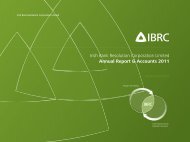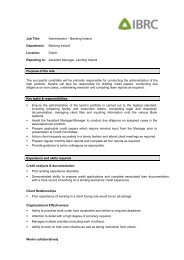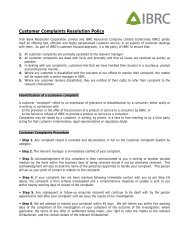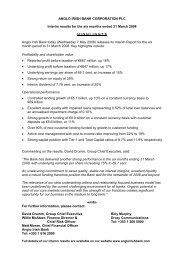Annual Report & Accounts 2009 - Anglo Irish Bank
Annual Report & Accounts 2009 - Anglo Irish Bank
Annual Report & Accounts 2009 - Anglo Irish Bank
Create successful ePaper yourself
Turn your PDF publications into a flip-book with our unique Google optimized e-Paper software.
<strong>Anglo</strong> <strong>Irish</strong> <strong>Bank</strong><br />
<strong>Annual</strong> <strong>Report</strong> & <strong>Accounts</strong> <strong>2009</strong><br />
The Group has evaluated the impact on its specific impairment charge, for both loans and advances to customers and loans classified as<br />
held for sale, of applying a lower estimate of the realisable value of collateral and of a change in the timing of the realisation of these<br />
assets. The <strong>Bank</strong> estimates that a decrease of 10% in realisable collateral values on currently impaired loans would have increased the<br />
impairment charge for the period by approximately €2.0bn. Similarly, an extension of one year in the timing of the realisation of these<br />
assets would have increased the impairment charge by approximately €0.6bn. These estimates are based on impaired loans at<br />
31 December <strong>2009</strong>. The methodology and assumptions used for estimating both the amount and timing of future cash flows are<br />
reviewed regularly.<br />
An additional incurred but not reported ('IBNR') collective provision is required to cover losses inherent in the loan book where there is<br />
objective evidence to suggest that it contains impaired loans, but the individual impaired loans cannot yet be identified. This provision<br />
takes account of observable data indicating that there is a measurable decrease in the estimated future cash flows from a group of loans<br />
with similar credit risk characteristics, although the decrease cannot yet be identified within the individual loans in the group.<br />
This provision is calculated by applying incurred loss factors to groups of loans sharing common risk characteristics. Loss factors are<br />
determined by historical loan loss experience as adjusted for current observable market data. Adjustments reflect the impact of current<br />
conditions that did not affect the years on which the historical loss experience is based and remove the effects of conditions in the<br />
historical period that do not exist currently. The provision amount is also adjusted to reflect the appropriate loss emergence period. The<br />
loss emergence period represents the time it takes following a specific loss event on an individual loan for that loan to be identified as<br />
impaired. The loss emergence period applied in the period was six months (30 September 2008: twelve months).<br />
The future credit quality of loan portfolios against which an IBNR collective provision is applied is subject to uncertainties that could<br />
cause actual credit losses to differ materially from reported loan impairment provisions. These uncertainties include factors such as local<br />
and international economic conditions, borrower specific factors, industry trends, interest rates, unemployment levels and other external<br />
factors. For loan impairment details, see note 27.<br />
Assets classified as held for sale<br />
Assets that the <strong>Bank</strong> believes will be transferred to NAMA are classified as held for sale in the statement of financial position. The <strong>Bank</strong><br />
has no control over the quantity of eligible assets that NAMA will acquire or over the valuation NAMA will place on those assets. NAMA<br />
has not confirmed to the <strong>Bank</strong> the total value of eligible assets it expects to purchase or the consideration it will pay in respect of those<br />
assets. Assets continue to be measured on the same basis as prior to their reclassification as held for sale.<br />
Assets will continue to be carried in the statement of financial position until they legally transfer to NAMA. The amount of consideration<br />
received from NAMA will be measured at fair value and any difference between the carrying value of the asset on the date of transfer<br />
and the consideration received will be recognised in the income statement.<br />
Impairment of available-for-sale financial assets<br />
In the case of debt instruments classified as available-for-sale financial assets the Group has considered the decline in fair values to<br />
ascertain whether any impairment has occurred. Impairment is recognised when there is objective evidence that a specific financial asset<br />
is impaired. Evidence of impairment is assessed by reference to the underlying assets of the debt instrument, the most up to date market<br />
valuations and whether there is evidence of a significant or prolonged decline in fair value, and all other available information. The<br />
determination of whether or not objective evidence of impairment is present requires the exercise of management judgement,<br />
particularly in relation to asset backed securities (‘ABS’) where exposures are not to a single obligor but rather to a diverse pool of<br />
underlying collateral. In addition, these investments also include credit enhancement features such as over-collateralisation or<br />
subordination that must also be evaluated in the impairment assessment.<br />
Carrying amount of investment property<br />
Investment properties held at cost are reviewed regularly to determine their recoverable values and to assess impairment, if any. Where a<br />
value in use calculation is performed as part of this review, management estimates the future cash flows expected to be derived from the<br />
asset. Expectations of future cash flows, and any variations in their amount or timing, are subject to management judgement. In some<br />
cases, recoverable amount is based on management estimates.<br />
Fair value<br />
Fair value is the amount for which an asset could be exchanged, or a liability settled, between knowledgeable and willing parties in an<br />
arm's length transaction. Fair values are determined by reference to observable market prices where these are available and are reliable.<br />
Where representative market prices are not available or are unreliable, fair values are determined by using valuation techniques which<br />
refer to observable market data. These include prices obtained from independent third party pricing service providers, comparisons with<br />
similar financial instruments for which market observable prices exist, discounted cash flow analyses, option pricing models and other<br />
valuation techniques commonly used by market participants. Where non-observable market data is used in valuations, any resulting<br />
difference between the transaction price and the valuation is deferred. The deferred day one profit or loss is either amortised over the life<br />
of the transaction, deferred until the instrument’s fair value can be determined using market observable inputs or realised through<br />
settlement, depending on the nature of the instrument and availability of market observable inputs. The accuracy of fair value<br />
calculations could be affected by unexpected market movements when compared to actual outcomes. Due to the increasing significance<br />
of credit related factors, determining the fair value of corporate interest rate derivative financial assets requires considerable judgement.<br />
In the absence of unadjusted quoted market prices, valuation techniques take into consideration the credit quality of the underlying<br />
loans when determining fair value.<br />
Expected life of lending<br />
IAS 39 requires interest and arrangement fees which form an integral part of the return earned from lending to be measured using the<br />
effective interest rate method. The effective interest rate is the rate that discounts estimated future cash receipts and payments through<br />
the expected life of the loan or, when appropriate, a shorter period to the net carrying amount of the loan.<br />
Management uses judgement to estimate the expected life of each loan and hence the expected cash flows relating to it. The accuracy<br />
of the effective interest rate would therefore be affected by unexpected market movements resulting in altered customer behaviour and<br />
differences in the models used when compared to actual outcomes.<br />
57






